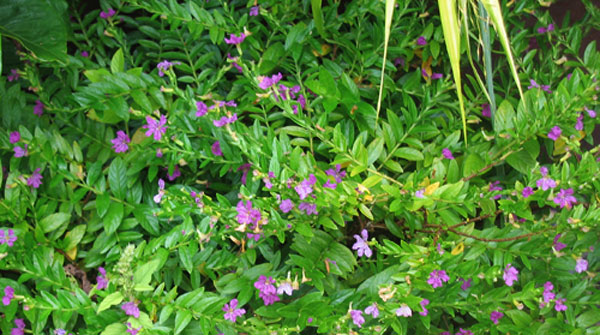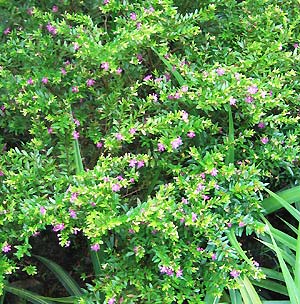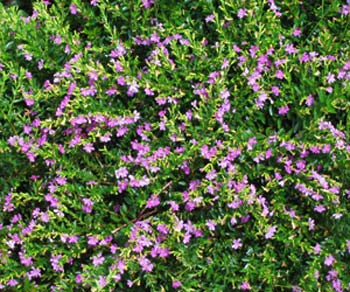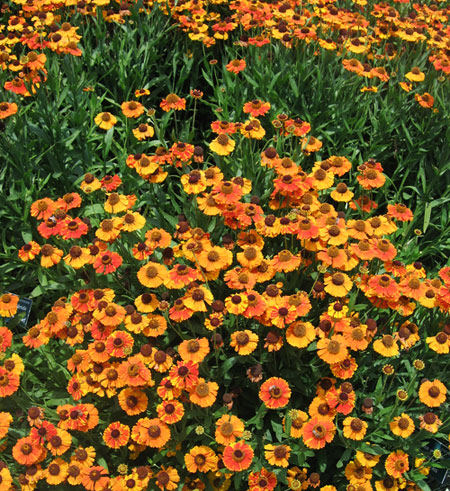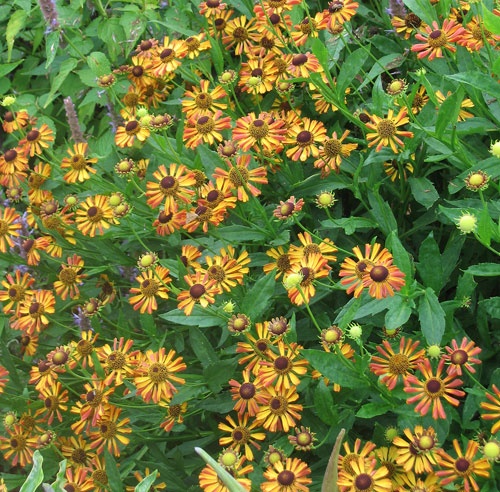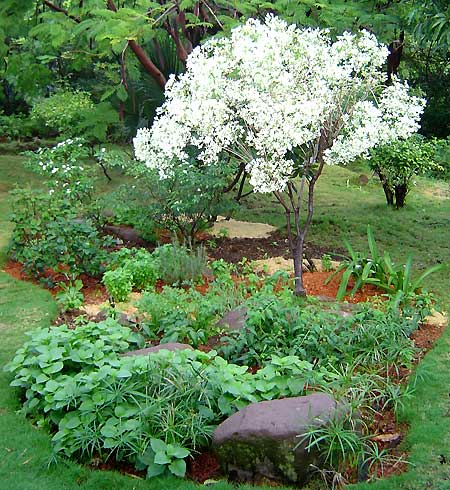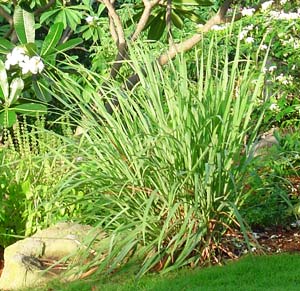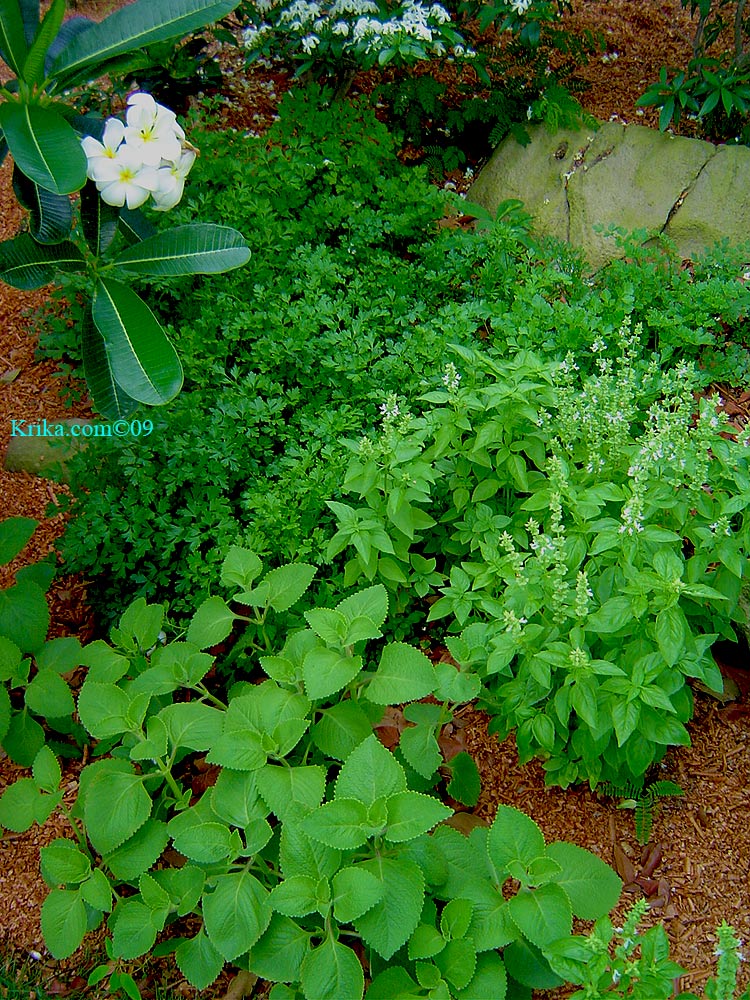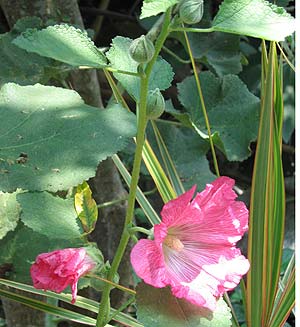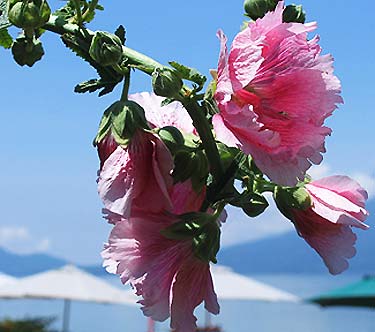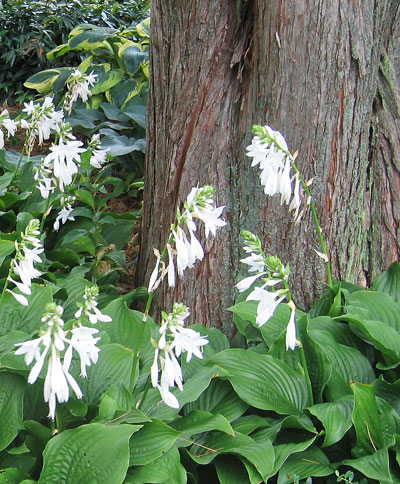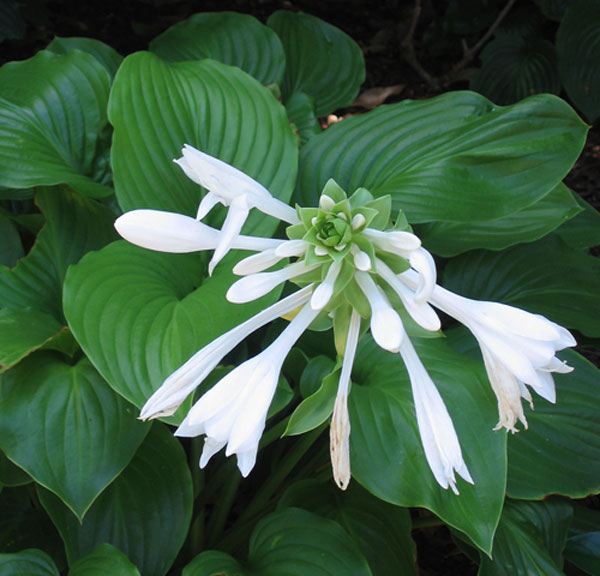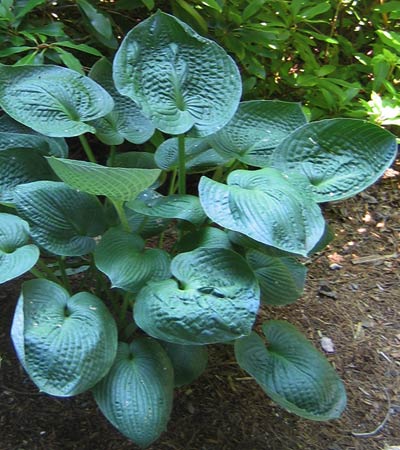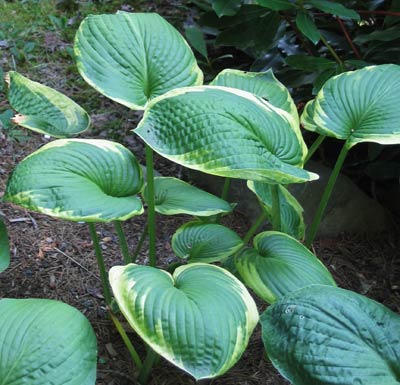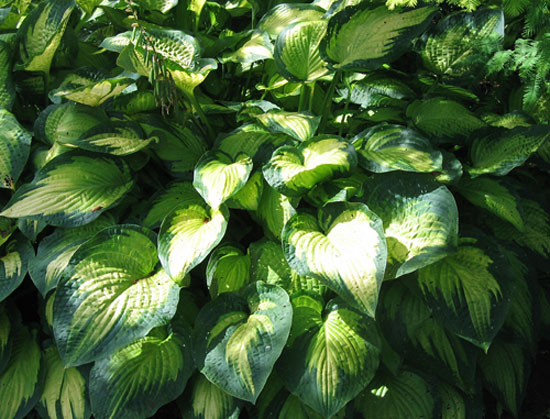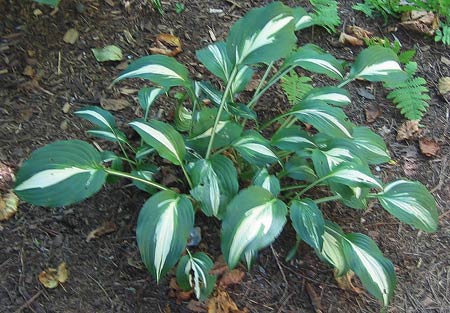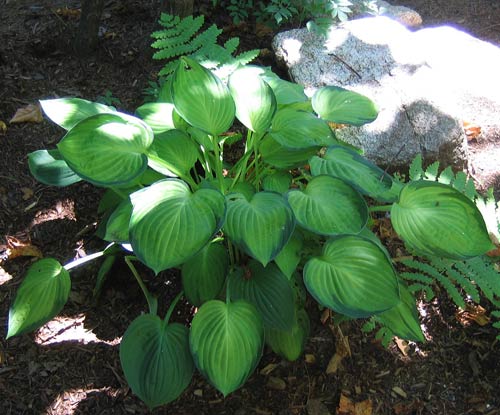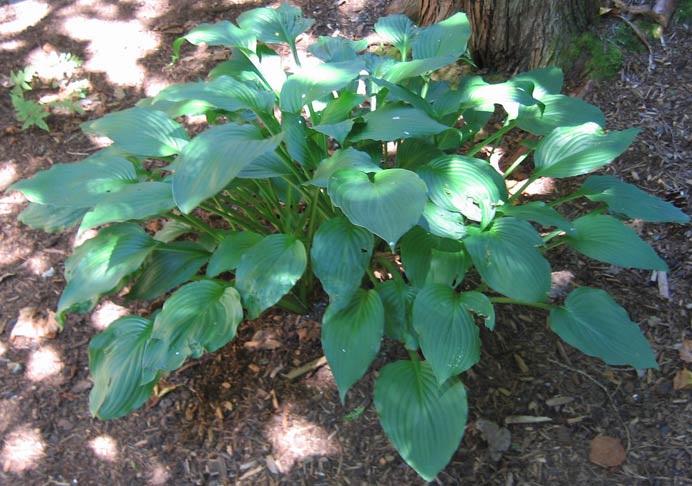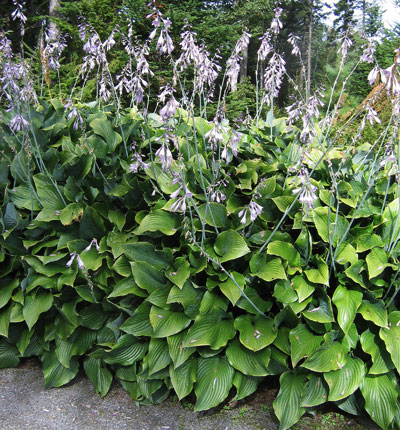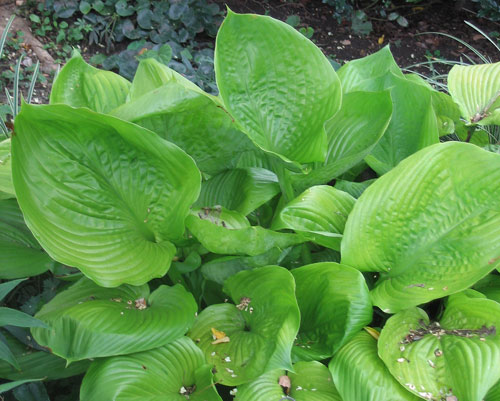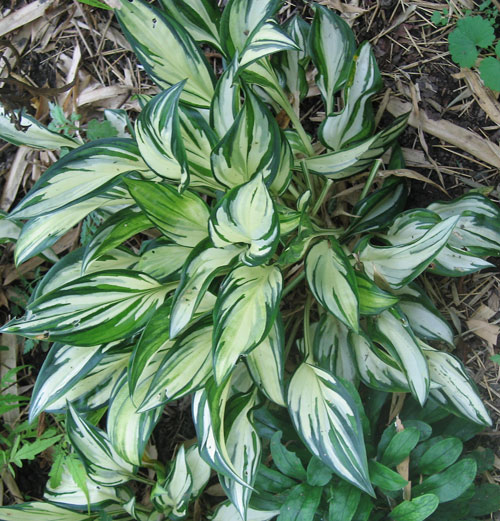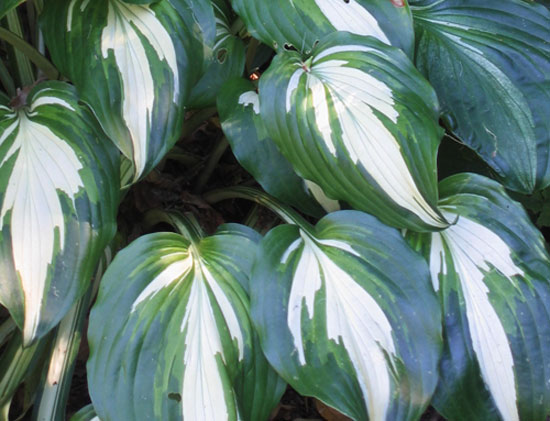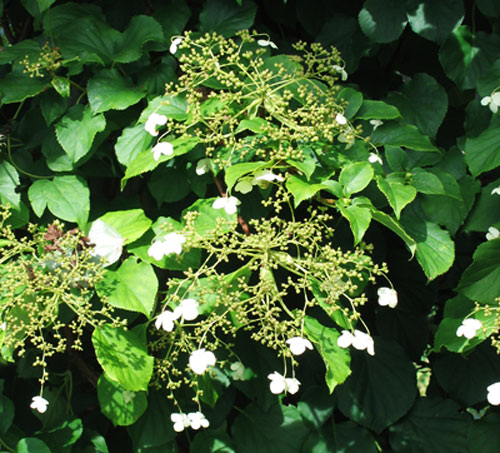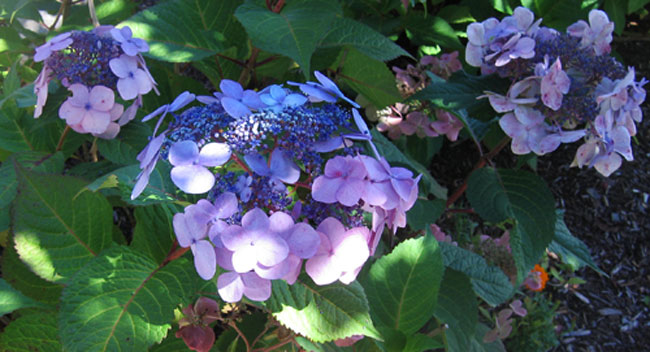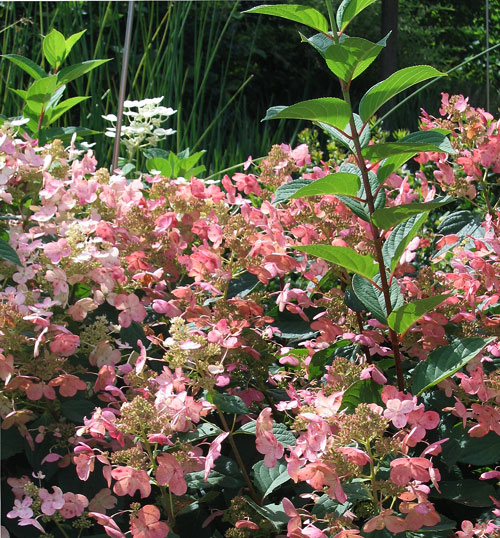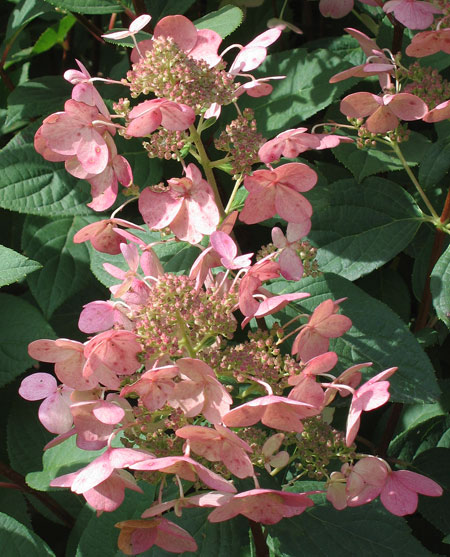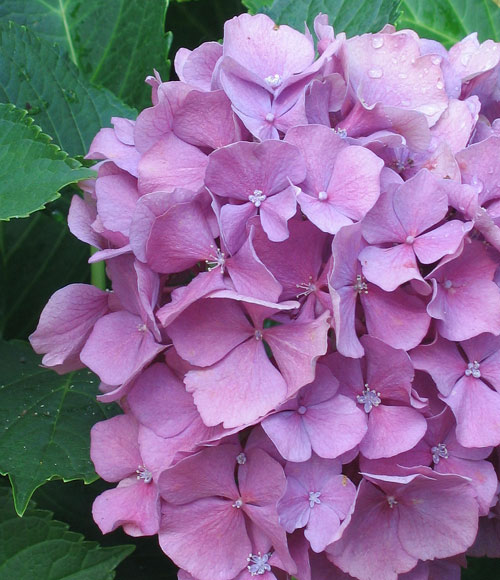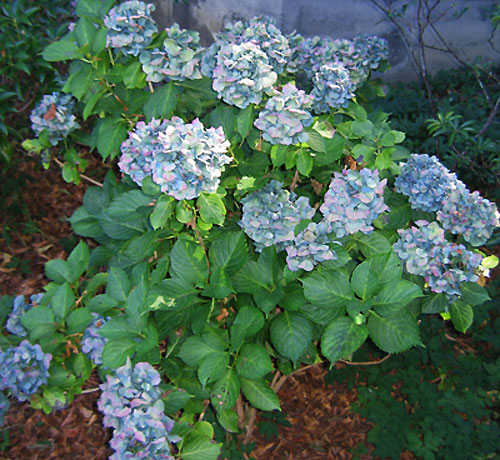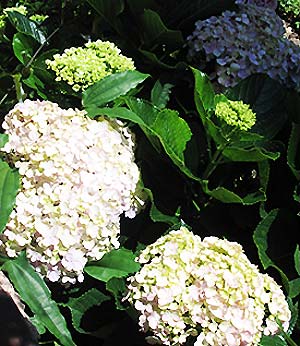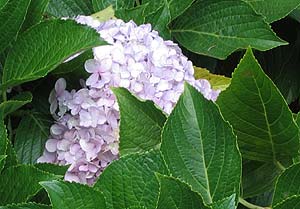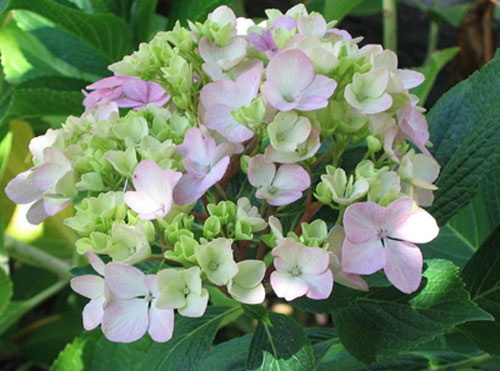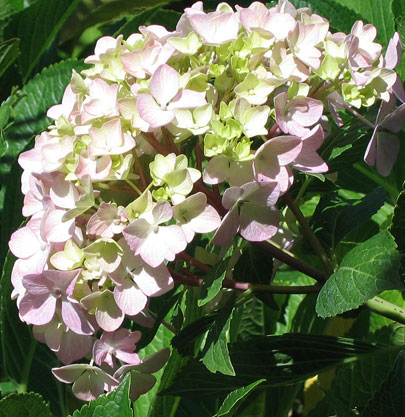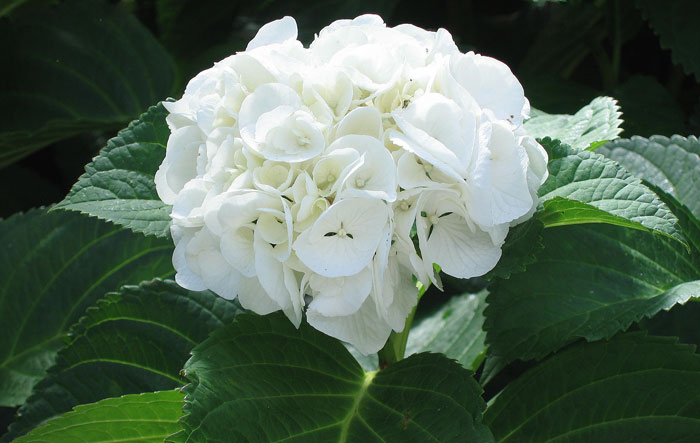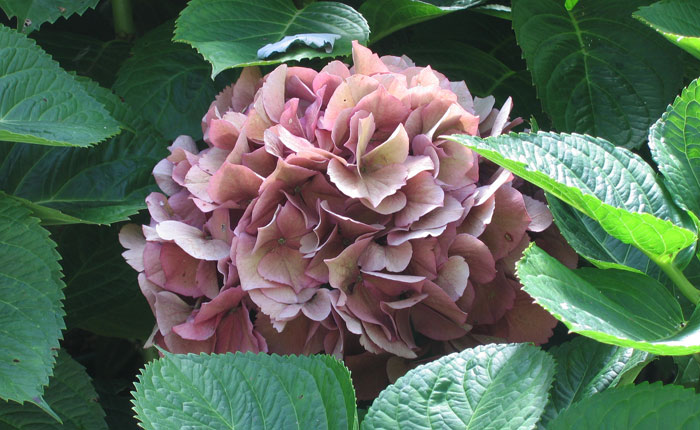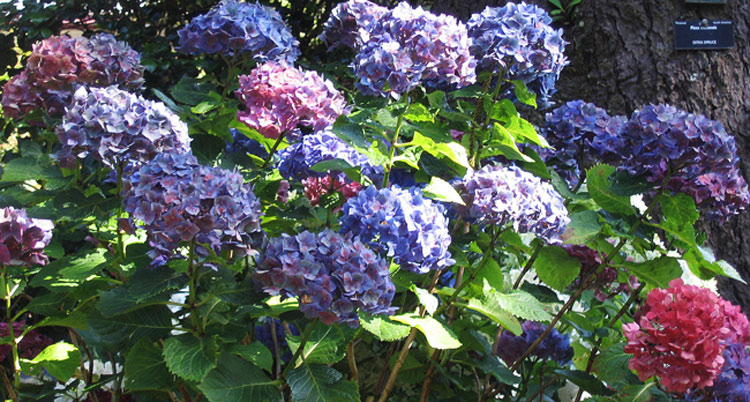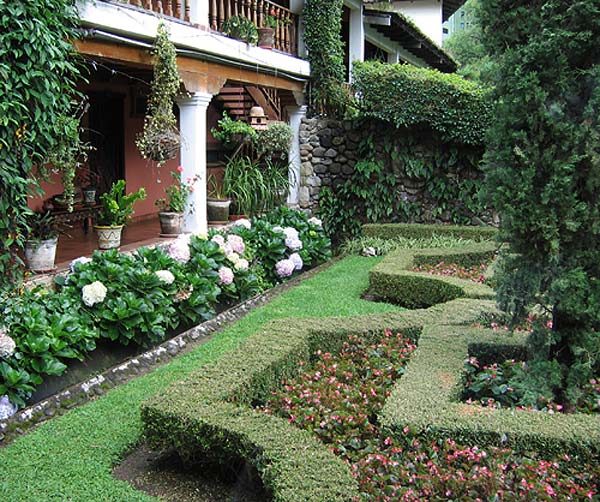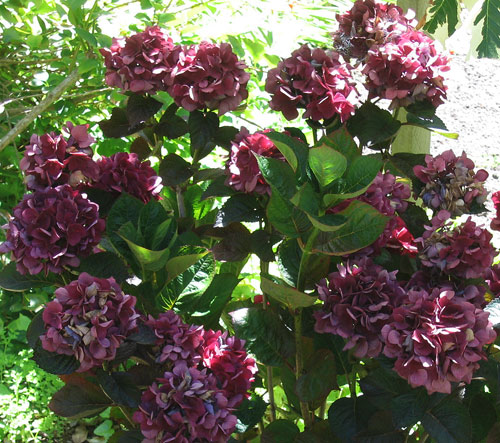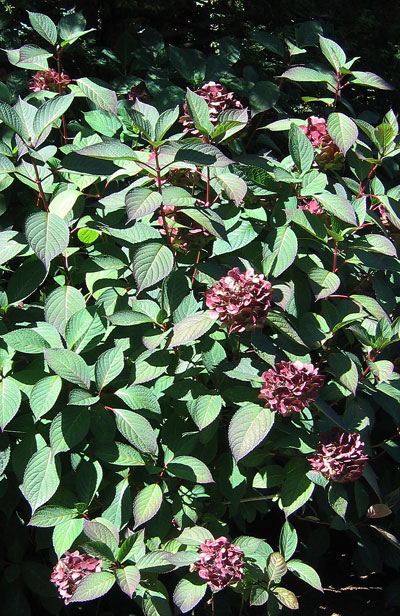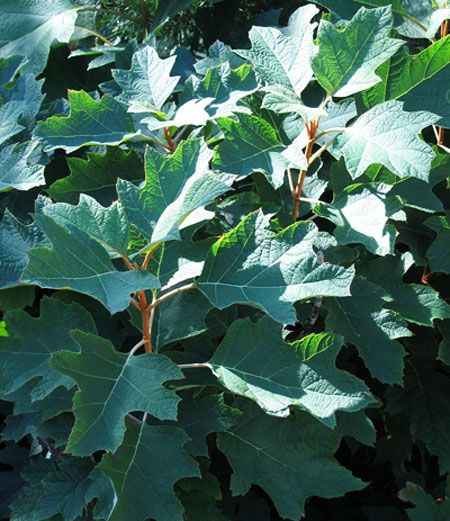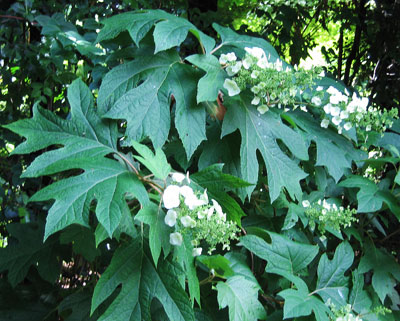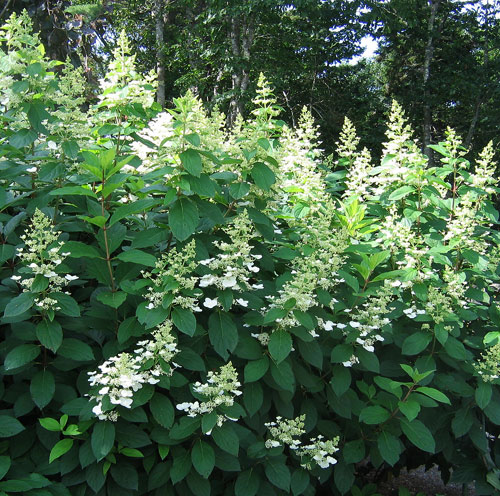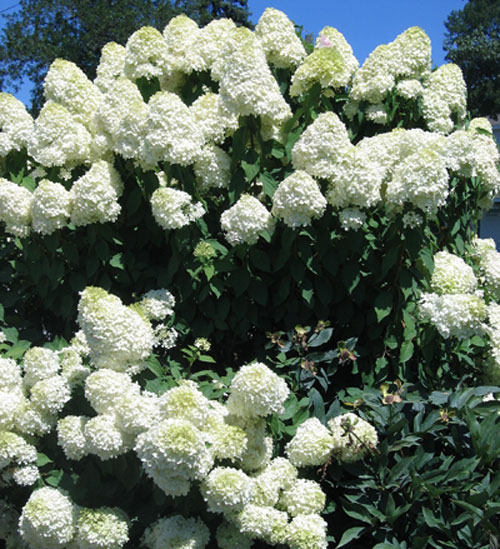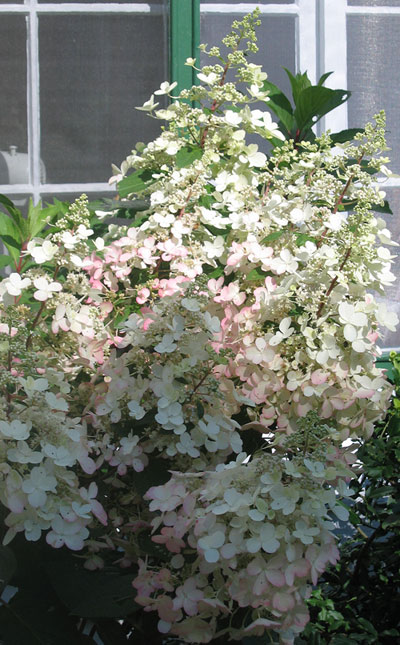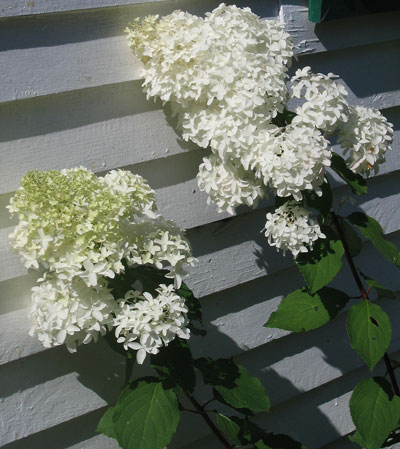| GreenGardeningCookingCuring.com | H
PAGE |
| HOME |
| Tour Our Destination Websites | Taxco-Today.com | Oaxaca-Today.com | Montserrat-Today Site |
| See our silver designs at Krika.com | Read our travel stories and other tales at Krika.com |
|
|
HEATHER |
|||
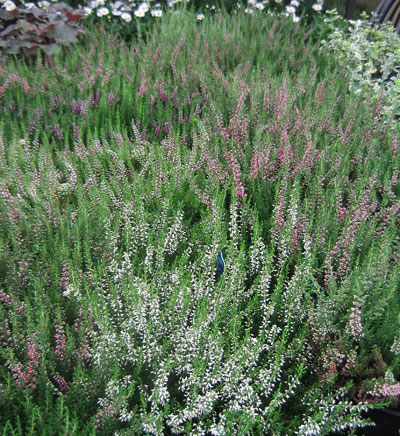 Common
Heather Calluna vulgaris Common
Heather Calluna vulgarisBenefits: Heather was used in past centuries for a variety of things ranging from being a vegetable dye to giving up some of its foliage in the making of malt beer. Its claim to fame now is as the perfect plant for acid soils. From: Europe, Iceland, the Faroe Islands, the Azores Photographed: Somewhere on the road in Rhode Island in 2013. Planting and Care: This perennial heather will grow to be a foot or a foot and a half tall and prefers to grow in full sun in a moist area of the garden. It will do best in acidic soils. Text and Photograph ©GreenGardeningCookingCuring.com 2014/2018 |
|||
|
|||
|
|||
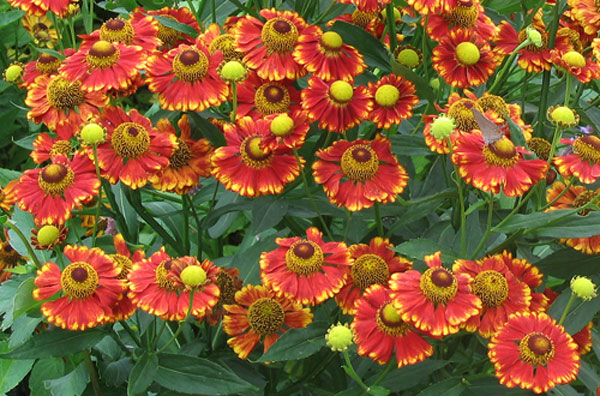 Helen's
Flower 'Tie Die', Fall Sneezeweed, Dogtooth Daisy Helenium
autumnale Helen's
Flower 'Tie Die', Fall Sneezeweed, Dogtooth Daisy Helenium
autumnale This colorful and distinctive flowering plant is a perennial which makes it even more appealing. It is known to grow to as much as 5 feet in height. Benefits: Helen's flower has been used to treat colds and headaches as well as being beneficial in treating intestinal worms. From: Wet areas in New England Photographed: On the left in the Blithewold Garden in Bristol, Rhode Island 2013. Planting and Care: Plant this beauty where you will want it in the future because it is a perennial. It likes to live in the sun and will be happy with any decent soil that it would prefer to be moist. The flowers will begin to appear in August and will continue the show until a real frost puts them to sleep for winter. Text and Photograph ©GreenGardeningCookingCuring.com 2013/2018 |
|||
|
|||
 Heliotrope,
Cherry Pie, Mary Fox, White Queen Heliotropium
arborescens Heliotrope,
Cherry Pie, Mary Fox, White Queen Heliotropium
arborescensBenefits: Their charms are immune to foraging deer. From: Southern tropical US most likely. It is mentioned in very old texts including those in Greek so its origins remain something of a mystery. Photographed: In the Thuya Garden, Mt. Desert Island, Maine, 2013. Planting and Care: Growing anywhere from 1 to 4 feet in height, heliotropes are perennials often grown as annuals. They are normally at home in temperate climates, but they will very much enjoy the hot dry summers in warmer climates. Heliotropes flower for a long time, but when a frost arrives it will put all of that to an end. Plant them in good loose soil where they will get full sun for most of the day with shade from the hot sun in the later afternoon. Warning: All parts of this plant are highly toxic. Text and Photograph ©GreenGardeningCookingCuring.com 2013/2018 |
|||
| Heralds Trumpet Please See the "E" Page - EASTER LILY VINE | |||
|
The herb garden at our former home in Montserrat in the Caribbean West Indies While
it is traditional to grow only herbs in a garden like this,
I thought
it would be more interesting and provide more places on the property
for herbs to grow if they were planted intermixed in
ornamental
garden beds. This garden became a real centerpiece for herbs for
a while and though we still called it the "Herb Garden,"
it took on a more exotic flavor with several varieties
of canna lilies and amaryllis planted. Some of the herbs
were moved on to other garden
beds, but we still had basil, parsley, fitweed (a tropical cilantro
alternative), Cuban thyme, lemon grass, chives and rosemary. |
|||
|
|||
In
this lightly shaded part of the Herb Garden in the photograph
below we had basil, parsley and Cuban thyme growing underneath the
frangipani and pinwheel jasmine. |
|||
|
|||
| Highway Ice Plant See the "I" Page -- ICE PLANT | |||
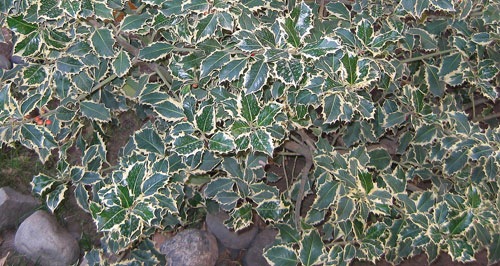 Holly, Variegated Ilex
aquifolium 'Argentea Marginata' Holly, Variegated Ilex
aquifolium 'Argentea Marginata'I think this wonderful old standby shrub, benefits from the simplicity of being a deep green with bright red berries. The variegated type in this photograph just seems too busy; you can barely see the red berries. Benefits: This holly will attract both birds and butterflies. From: Western and southern Europe, northwest Africa, and southwest Asia Photographed: At our hotel in Calafate, Patagonia, Argentina. Planting and Care: Plant this holly in full sunlight in moist, well-drained, fertile soil. Surprisingly, this is one of those male and female plants, so plant one of each to get lots of berries. Warning: All parts of this plant are highly toxic to humans. Text and Photograph ©GreenGardeningCookingCuring.com 2013/2018 |
|||
| Hollyhock Alcea
rosea What traditional New England garden doesn't have a hollyhock or two? These are old standbys for good reason and I've now found them growing happily in the Guatemalan highlands in a lovely hotel garden by Lake Atitlan. They flower in early summer and reach 5 to 8 feet in height making them excellent background plants. Benefits: Hollyhocks are said to have several curative qualities with such odd companions as bed-wetting and bleeding gums. From: Southwestern China Photographed: In the Botanical Garden of Hotel Atitlan at Lake Atitlan in Guatemala. Planting and Care: Hollyhocks are perennials liking full sun and regular rainfall or watering. In warmer places they will tolerate some mid-day shade, but always plant them away from windy areas. If you are lucky to live near a well supplied garden shop, buy plants and set them out directly in the garden. If you are less lucky, have a go at planting seeds, but the plants will take two years to bloom making it a biennial. Oddly enough this plant comes with flowers of different colors and each has a soil preference so check with your garden shop or read your seed packet carefully. Aphids and spider mites like hollyhocks as much as we do so consider using rotenone as a control or try a soap spray. Text and Photographs ©KO 2010 and ©GreenGardeningCookingCuring.com 2018 |
|||
|
|||
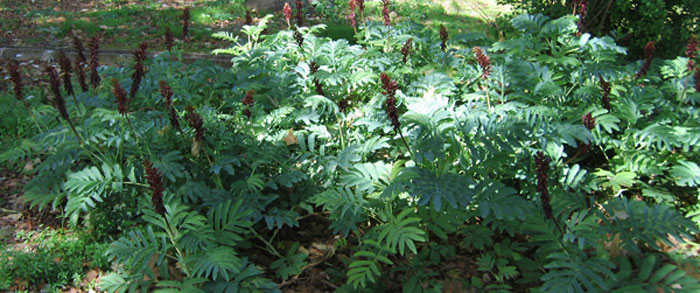 Honey
Flower, Honey Bush Melianthus major Honey
Flower, Honey Bush Melianthus majorThis is an interesting perennial flowering evergreen shrub growing to be over 8 feet tall. Benefits: From: South Africa Photographed: In the Botanical Garden in Palermo, Sicily, in Italy in 2012. Planting and Care: Text and Photograph ©GreenGardeningCookingCuring.com 2014/2019 This was one of my plant mysteries until it was identified by a visitor to my site. I am very grateful for the help. |
|||
 **Honeysuckle
Vine, Golden-and-Silver Honeysuckle, Japanese Honeysuckle Lonicera
japonica **Honeysuckle
Vine, Golden-and-Silver Honeysuckle, Japanese Honeysuckle Lonicera
japonicaI remember a bush variety of this heavenly smelling plant from my childhood in Rhode Island. I would probably carry one with me every where we go if only I could. Benefits: This lovely smelling flowering vine attracts butterflies and hummingbirds. From: Eastern Asia Photographed: In the Botanical Garden of Hotel Atitlan at Lake Atitlan in Guatemala. Planting and Growth: This vigorous perennial vine is able to grow up to 30 feet high on a tree or other support. It prefers being in full sun and receiving regular rainfall or watering. Text and Photograph ©KO 2010 and ©GreenGardeningCookingCuring.com 2018 |
|||
|
|||
Horseradish Amoracia
rusticana |
|||
| **Horsetail See the "C" Page -- CASUARINA TREE | |||
Hostas, with all of the their leaf sizes and colors and their blossoms, make perfect additions to shady areas of the garden. They can be used as background plants or border plants or even centerpiece plants, if carefully done. They are easy to care for and live in enough shade where it is often difficult to find other appealing and reliable greenery. I have fond memories of popping the flower buds when I was a little girl, something I now regret. Hosta is a plant I remember well from childhood when I didn't think it was something special -- times change as do attitudes. I now rather like hostas and would have them in my shady garden areas if I still had a garden. With advancing global warming it's good to know this plant is heat tolerant. Hostas have become very popular and hundreds of hybrids are now available. Surely one or more of them will win your heart and be perfect for the garden site you have in mind. |
|||
| Plantain
Lily, August Lily Hosta plantaginea This is a particularly pretty hosta. The deep green of its large leaves contrast perfectly with the bright white of its fragrant flowers. As a perennial it will grow to be about 2 feet tall and twice as wide. Benefits: The fragrant flowers on this plant bloom in the afternoon and are hummingbird attractants. From: Russia through to Korea and Eastern China Planting and Care: Hostas are especially easy to care for. Plant them in bright shady areas even in a cold climate and they will do just fine. They prefer moist, rich, composted soils, but will do well with less. Text and Photographs ©GreenGardeningCookingCuring.com 2014/2018 |
|||
|
|||
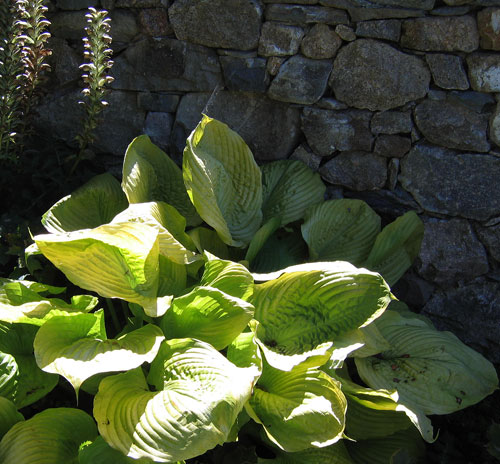 Hosta
'Sum and Substance' Hosta Hosta
'Sum and Substance' HostaThis hosta is considered apple green. With its large leaves it will be a stand out in any shady garden. You can expect it to be about 3 feet tall and 6 feet wide giving it the potential for being a shade garden centerpiece. Benefits: Hummingbird attractant From: Hybrid Photographed: Blithewold Mansion, Gardens and Arboretum in Bristol, Rhode Island, in 2013. Planting and Care: Unlike most hostas, this one prefers having morning sun along with spending the rest of the day in bright shade. It is also less accommodating in its reluctance to share its composted dirt home with other plants so avoid giving it the kind of competition it would receive if planted beneath a tree. Make sure it has a moist, mulched situation and you will be especially happy with its performance. Text and Photographs ©GreenGardeningCookingCuring.com 2014/2018 |
|||
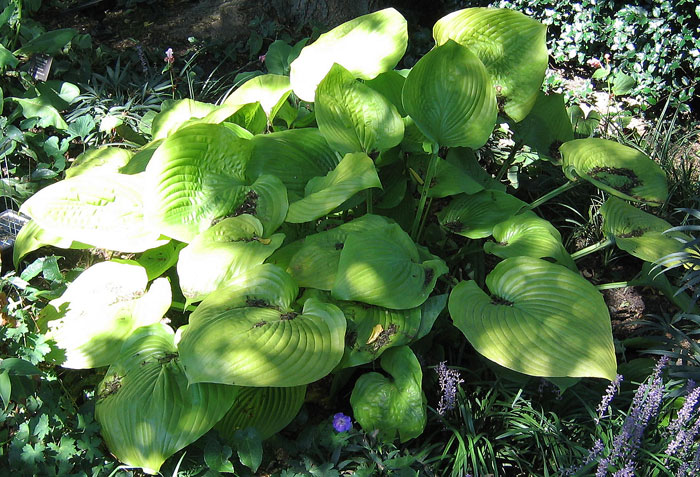 |
|||
|
|||
If
You Know What This Hosta Is, Please Contact Me |
|||
|
|||
If
You Know What This Hosta Is, Please Contact Me
|
|||
|
|||
|
|||
| Hottentot Fig See the "I" Page -- ICE PLANT | |||
CLIMBING
HYDRANGEAS |
|||
| Climbing
Hydrangea Hydrangea anomala ssp. petiolaris Benefits: It is said that parts of this plant are edible and it seems to be most commonly used for this purpose in Japan. It is also said that hydrangeas are highly poisonous so I would not recommend taking a bite. From: Japan, Sakhalin, Korea, Taiwan Photographed: Coastal Maine Botanical Gardens, Boothbay Maine, 2013. Planting and Care: The climbing hydrangea will grow best in well-drained, moist, rich and fertile soils. It prefers bright shade or dappled sunlight and will normally not grow well in full sun. It tends to bloom early in the summer season. When it is at its best, it will grow to be almost 40 feet in height. Warning: All parts of this plant are poisonous. Text and Photograph ©GreenGardeningCookingCuring.com 2013/2018 |
|||
|
|||
LACECAP
HYDRANGEAS |
|||
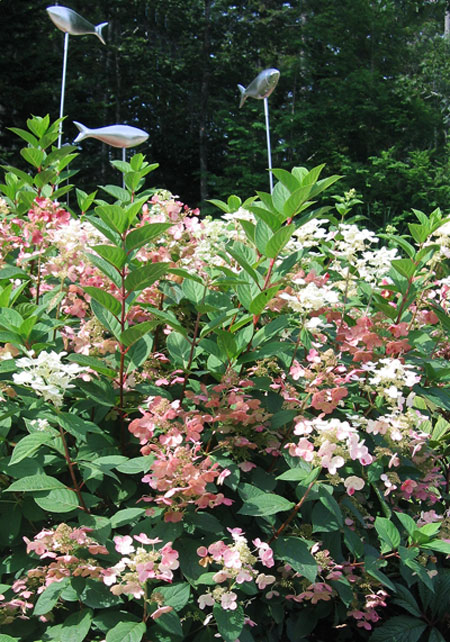 Lacecap
Hydrangea Hydrangea macrophylla normalis Lacecap
Hydrangea Hydrangea macrophylla normalisBenefits: It has been said that it has medicinal benefits, but since the entire plant is poisonous I find that hard to believe. From: Eastern Asia Photographed: In the Coastal Maine Botanical Gardens, Boothbay, Maine, 2013, unless otherwise noted. Planting and Care: Morning sun works best for all hydrangeas keeping them free of the hot mid-day and afternoon sun. Plant yours with enough space for it to reach adulthood without pruning. Be sure that it is set in good soil and that it receives enough rainfall or watering to keep the soil moist, not wet. Fertilize these plants in early spring or summer and then sit back and enjoy the show. Warning: All parts of this plant are poisonous. Text and Photograph ©GreenGardeningCookingCuring.com 2013/2018 |
|||
|
|||
|
|||
Photographed: At
the Roger Williams Park Botanical Center, Providence, RI, in 2013. 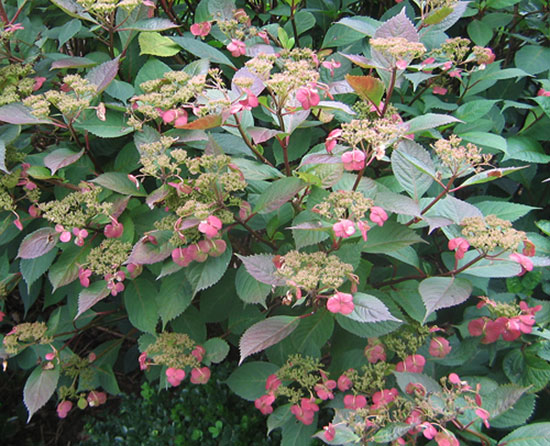 |
|||
MOP
HEAD HYDRANGEAS |
|||
|
|||
|
|||
|
|||
|
|||
Photographed: In the Winter Garden in Auckland, New Zealand, in 2013.
|
|||
Photographed: In the Winter Garden in Auckland, New Zealand, in 2013.
|
|||
Photographed: In the Wellington Botanic Garden in Wellington, New Zealand, in 2013.
|
|||
MOP HEAD HYDRANGEA LANDSCAPING Landscaping
with hydrangeas is a terrific idea as you can see in the photograph
below where it is used to disguise a foundation. The foliage
is lush and beautiful and the flowers are huge and
bountiful.
The
plants
have character,
but also make a wonderful backdrop for individual plants that
are more exotic in nature. |
|||
Photographed: At the Hotel Atitlan on Lake Atitlan in Guatemala.
|
|||
PREZIOZA HYDRANGEA |
|||
| Prezioza
Hydrangea Hydrangea
macrophylla Prezioza, Hydrangea serrata Preziosa, Hydrangea
macrophylla Preziosa This is a mop head hybrid being about half the size of a normal mop head or about 3 to 4 feet wide and tall. Other than size I find it difficult to distinguish between these two hydrangeas. It will normally begin blooming in July and will do so through September. Benefits: None mentioned except that it is a prolific bloomer. From: This is a hybrid. Planting and Care: Plant this hydrangea where it will not normally receive hot afternoon sun and give it watering or rainfall that is normal in your area and it should do just fine. Text and Photographs ©GreenGardeningCookingCuring.com 2018 |
|||
|
|||
OAKLEAF
HYDRANGEAS |
|||
Oakleaf
Hydrangea Hydrangea Quercifolia This shrub mystery was solved by Ursula G. writing from Southern Germany |
|||
|
|||
|
|||
PANICLE
HYDRANGEAS |
|||
| Panicle
Hydrangeas Hydrangea paniculata Panicle hydrangeas are distinguished largely by the shape of their flowers. Unlike the smooth round mop-head, panicles have a conical flower shape. Within the panicle family there are a variety of flower types as you may see in the photographs below. Benefits: From: Southern and eastern China, Korea, Japan and Russia Planting and Care: When well settled you may expect this plant to grow from about 15 to 30 feet tall. It is said to be extremely tolerant and hardy and it will handle more direct sun than most other hydrangeas. Plant it in good soil and ensure that it has sufficient moisture and you won't be disappointed with its performance. Its flowers are white moving towards pink as they age. Text and Photographs ©GreenGardeningCookingCuring.com 2013/2018 |
|||
|
|||
|
|||
Photographed: At the Maine Idyll Motor Court in Freeport, Maine, 2013
|
|||
Photographed: At a roadside garden shop in Maine, 2013
|
|
